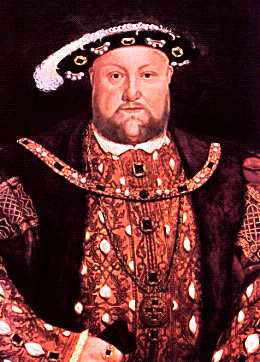Henry VIII
Poet, musician, sportsman, scholar: Henry VIII seemed like the ideal monarch of the humanists. But the usual temptations of power, and the complication of a marriage that began in controversy and ended in divorce made him in the end a less than admirable character.
The problem was that his first wife, Catherine of Aragon*, had earlier been married to Henry's elder brother, Arthur, Prince of Wales. The marriage lasted less than a year, as Arthur died in April 1502, but the doctrine of the time meant that it was technically incestuous for Henry to marry his brother's wife--just as Hamlet protests that his mother's marriage to Claudius is incestuous*.
What were Henry's reasons* for pursuing such a problem-ridden marriage?
Poet and musician?
Henry was an accomplished musician and poet, as Shakespeare (or Fletcher) reminds us in the play Henry VIII:
In sweet music is such art,
Killing care and grief of heart
Fall asleep, or hearing die.
(3.1.12-14)
One poem Henry wrote, and set to music, is an appropriate celebration of good times--eat, drink and be merry (or hunt, sing and dance):
Pastime with good company
I love and shall until I die.
Grudge who lust [will], but none deny;
So God be pleased, thus live will I;
For my pastance,
Hunt, sing and dance;
My heart is set
All goodly sport
For my comfort
Who shall me let [prevent]?
The site includes two other short pieces by Henry:
- A "Fantasie"
- A song, "Without Discord."
Footnotes
-
Catherine of Aragon
Catherine was the daughter of Ferdinand of Aragon and Isabella of Castile, the two rulers who began the unification of Spain in the late 15th century. (Now part of north-eastern Spain, Aragon had been an independent kingdom until the unification.) Catherine's future in England was determined when she was only 3 years old by her betrothal to Henry VII's eldest son, Arthur (then only a baby). The couple met for the first time at their marriage 13 years later, but Catherine was widowed within a year when Arthur died from consumption.
Catherine's marriage to Arthur's brother, Henry, was quickly made possible, thanks to a dispensation from the Pope, but it was put on hold for 6 years during a power struggle in Spain; she was finally crowned Queen of England at Westminster on Midsummer's Day, 1509.
The first 15 years of Catherine's marriage to Henry were relatively happy. They shared an interest in music, dancing and the new humanist learning; Catherine overlooked the king's pleasures with his mistresses and was treated with respect at court, acting as Regent during Henry's first expedition to France.
In 1536, three years after the divorce, Catherine died suddenly from an unknown illness.
-
"That incestuous . . . beast"
Hamlet's first soliloquy explores his feelings about his mother's hasty and morally dubious marriage:
Within a month,
Ere the salt of most unrighteous tears
Had left the flushing in her gallèd eyes,
She married. O, most wicked speed, to post [hurry]
With such dexterity to incestuous sheets!
(1.2.153-57)
The Ghost makes the same point, as he calls Claudius "That incestuous, that adulterate beast" (1.5.41)
-
Why marry Catherine?
The importance of England's alliance with Spain, which marriage with Catherine would cement, was such that the Papal dispensation was obtained to make it legal. Henry needed Spain as an ally if he were to renew war with France in order to fulfil his dream of regaining the territories won by Henry V.
-
A chapel fit for a king
Both King's College Chapel, Cambridge, and Henry VIII's Chapel in Westminster Abbey are a fine examples of the late Gothic style in England.
Henry also received copies of the tapestries designed by the great Renaissance painter Raphael for the Sistine Chapel; click to learn more about them.
